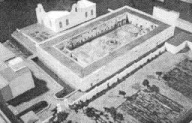Compiled by A.M. van Rensburg and B.J. Vosloo
Wikipedia points out that the Canadian concept of cultural mosaic suggests that the integration of the many different cultures in Canada combine like a mosaic, as opposed to the more traditional notion of a cultural melting pot.
The idea of cultural mosaic is almost certainly just as applicable to South Africa, where ethnicity is juxtaposed but does not merge into a single homogeneous culture. Each culture more or less keeps its own distinct qualities.
This phenomenon conceivably has much to do with the passage of South African history since Jan van Riebeeck landed in the Cape in 1652 to establish a Vereenigde Oost-Indische Compagnie (VOC) halfway station.
It is common knowledge that many South Africans are descendants of VOC employees. However, the arrival of the French Huguenots, the 1820 and Bergtheil, and others, such as the Indian indentured labourers who were brought to Natal between 1890 and 1911, and the Chinese labourers who arrived in 1904, also made a major contribution to the South African cultural mosaic.
This piece, however, presents an edited account of the people who worked for the VOC, and gives us some insight into what kind of folks they may have been.
Organization and leadership structures were varied in the various VOC outposts around the world. This required many people with the essential jobs skills. It has been suggested that the limited size of the Dutch population meant there was insufficient personnel available with the requisite skills to run a business of the scale of the VOC. As a consequence, workers at all levels were often drawn from other European countries or from Asia.
In Dutch Asiatic Shipping, Bruijns points out that the VOC fitted out 4 700 ships, sending 1 million people to Africa and Asia. Only about one third ever returned to Europe.
Peter Reynders, in his article Why did the largest corporation in the world go broke? wrote, “The largest group of personnel in the VOC was the military. Records show a breakdown of the military stationed on land in Asia in 1688 as a total of 7,806 out of 11,551 personnel. The number of sailors was roughly half that of the military. Over half of the soldiers came from outside the Dutch Provinces and included Germans, Portuguese, Scandinavians, Poles, English, Swiss, Flemish, even people from the Baltic States. The VOC was perhaps an early version of the French Foreign Legion, where unmarried male adventurers and 'riff-raff' from all over Europe could get a job.”
 |
In his Journaal van zijn verblijf aan de Kaap, Hulsof recorded that when High Commissioner Hendrik Adriaan van Reede tot Drakenstein (left) came to the Cape in 1685, the fiscal told him that the Free Burghers came from lower class families elsewhere in the world.
C.R. Boxer wrote, "It is undeniable that many unscrupulous individuals enlisted in the service of the VOC ... with the sole object of enriching themselves as quickly as possible, irrespective of the means. Others hoped to live a life of luxury in the East, which they could never afford to do at home. Others enlisted because through no fault of their own, they had no options but to emigrate. Others, such as bankrupts, might hope to recoup their losses and even to repay their creditors. Still others left their country for their country's good, or simply because their friends and families wanted to be rid of them.
Archivist H.C.V. Leibbrandt pointed out that as the VOC always required large numbers of new men and boys to fill the ranks in the different branches of its service, volunteers from all parts of the Continent flocked to Amsterdam with the intention of going to seek their fortunes. Men of every profession and trade signed up. But whether they were doctors, lawyers, surveyors, etc., every one was entered on the books of the VOC as a "soldier." Their salary was nine guilders per month. This was the lowest rank with which all had to commence their careers, and therefore it was very natural that when e.g. a surgeon died, he was succeeded nominally by a "soldier", who really was another qualified surgeon, still holding the rank of "soldier".
Few Dutch women migrated. Most that did were known as "company daughters", i.e. orphans, paupers, and prostitutes. They were reputed to be more sluttish than the most uncouth slave.
 |
| Slave routes |
PICTURE OF MAP ROUTES) Soon after Van Riebeeck’s arrival, slaves started forming a large part of the population. iBlog (click here to access) reports that during the entire period of slavery, from 1652 until 1834, around 63 000 new slaves were brought to the Cape. Of these more than half were from Africa and its islands of Zanzibar, Madagascar and the Mascarenes. Most of the slaves exported from the islands mentioned were captured on the mainland of East Africa and deep into East Central Africa. A further quarter of Cape slaves were from India-Bengal-Sri Lanka. Another quarter were from the array of islands of the Indonesian Archipelago. The rest were from a number of countries stretching from Persia to Thailand, Japan and China.
 |
| Slave lodge |
In the early years of the colony, several marriages took place between white men and slave women, due to the shortage of white women at the colony. Later, sexual intercourse between whites and slaves took place without a formal union. During most of its existence, the Company’s slave lodge was renowned as the town’s leading brothel.
So, also taking into account the South Africans of black African origin, our society presents a cultural mosaic second to none. Small wonder genealogists have their work cut out to trace the ancestry of locals.

